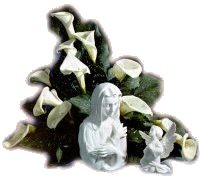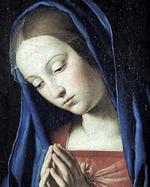Catholic Activity: Feasts of Mary in the Family

Ideas from Father Weiser on the five major feasts of Our Lady: Assumption, Immaculate Conception, Presentation, Annuncation and Nativity of Mary. (This was written before January 1 feast was changed to Solemnity of the Mother of God.)
DIRECTIONS
Of the five major feasts of the Blessed Virgin only two are holydays of obligation (Assumption and Immaculate Conception). The other three, however might very well be also kept with some fitting celebration, especially since they commemorate such important events in the lives of Jesus and Mary: the Purification (February 2), the Annunciation (March 25), and the Nativity of Mary (September 8).
On these three feasts at least some members of the family could attend the holy Sacrifice, if possible. Some devotional and religious celebration might be added to the regular daily routine. One custom which is kept in many families is the reading before dinner or at the family devotion in the evening of the Gospel from the Mass of the day.
Those who attend Mass on the feast of the Purification (Candlemas) should bring home to the family one or two of the blessed candles to keep in the house and burn on special occasions such as feast days, during novenas, in sickness, and in time of danger.
The feast of the Annunciation is a traditional day of prayer among farmers, to obtain through Mary's intercession blessing upon the spring planting. Perhaps our Catholic families could offer some prayers for the same intention on this day. It would make the children realize how much we depend on nature for our basic needs of the body, and teach them the lesson to pray for the temporal welfare not only of their family and friends but of all the people in the country.
The feast of the Assumption is the oldest and, in a sense, the greatest holyday of Mary. We celebrate not only her passing from this world but also her glorious assumption, with body and soul, into eternal bliss, and her "crowning" in heaven, that is, her elevation to the dignity of Queen over all creatures. For every Catholic family it should be a day of great devotion and joy. Many nationalities, especially the Italian and Portuguese people, celebrate this day with processions and festivities; the ships of fishing fleets are solemnly blessed, and people present each other with fruit or flowers in honor of Mary.
On the feasts of our Lady's Nativity we celebrate her earthly birthday, which was different from ours in that she was born without original sin. I know a home where the smaller children decorate the family shrine (which bears Mary's statue on this day) with flowers and evergreens after breakfast, and then sing "Happy Birthday" in her honor. In some places the school children start a novena in the home on this day, to pray for our Lady's blessing and help in the coming school year. High school and college students could easily make a similar novena on their own.
The feast of the Immaculate Conception reminds us that Mary was entirely free from original sin and that her soul was always pure and radiant with the fullness of God's grace. Coming at the start of a new ecclesiastical year, this feast might serve as the first great day of a devout and conscious preparation for Christmas. For parents it might present a fitting occasion to encourage the children in praying to Mary for help against temptations and for her protection against the dangers of bad company — a very real danger in our times.
Activity Source: Year of the Lord in the Christian Home, The (reprinted as Religious Customs in the Family) by Francis X. Weiser, S.J., The Liturgical Press; reprinted by TAN Books and Publishers, 1964






